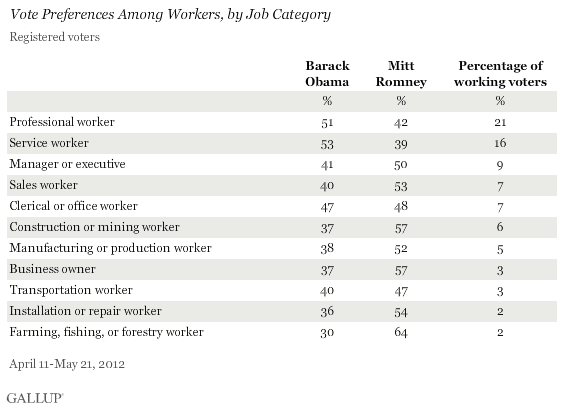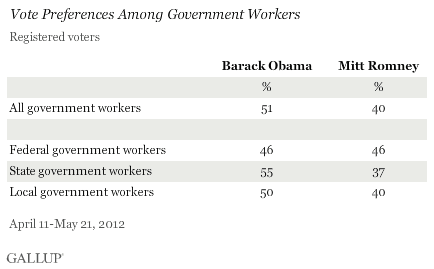PRINCETON, NJ -- Barack Obama has a significant lead over Mitt Romney among the 21% of American working voters who are classified as professionals, and among the 16% who are service workers. The two are essentially tied among clerical and office workers. Romney leads among all other job categories, including in particular the small segments of voters who work in farming and fishing, construction, and who own a business. He also has an edge among executives and managers.

These findings are based on an aggregate of Gallup Daily tracking interviews conducted April 11-May 21. Workers are categorized based on their responses to a question asking them to state the general type of work they do. Their answers are coded into one of the 11 categories that the U.S. federal government uses to classify workers. Overall in this sample of working voters, Romney and Obama are tied, at 46% each.
The results confirm that workers' vote choices are significantly related to the type of work they do. The largest category of workers is "professionals" -- which would include lawyers, doctors, scientists, teachers, engineers, nurses, and accountants. These professionals prefer Obama over Romney by 51% to 42%. In these data, 40% of professionals have postgraduate education, by far the highest proportion of any of the 11 job categories. Voters with postgraduate education are more liberal than average, and constitute a strong Obama support group.
The second-largest category of workers is service workers -- police officers, firefighters, waiters, fast-food workers, janitorial workers, and so forth. This group constitutes 16% of working voters, and favors Obama over Romney by 14 percentage points.
On the other hand, the third-largest category of workers is managers and executives (9% of working voters), and this group favors former business executive Romney by nine points over Obama.
Clerical and office workers (7% of working voters) are split in their vote preferences, while all other categories of workers, most of which make up a small proportion of all workers, favor Romney.
Romney's biggest lead is among the 2% of working voters who are classified as farming, fishing, or forestry workers. Their vote choice is 64% Romney, 30% Obama.
Government Employees -- Especially at the State Level -- Prefer Obama
In addition to the type of work people do, Gallup assesses worker attitudes based on government employment status. About 15% of all working voters in this sample are employed by federal (4%), state (6%), or local (5%) governments. These government workers, as a whole, support Obama over Romney, by 11 points. There are, however, significant differences by type of government employment. State workers, the largest group of government employees, are the strongest Obama supporters. Local government workers also tilt toward Obama, while federal workers split their vote, 46% for Romney and 46% for Obama.

Implications
Different types of American working voters have differing demographic characteristics, and given that these characteristics are related to political preferences, it is not surprising to find that workers' vote choice is related to the type of work they do.
Support for the two major-party candidates by job category doesn't follow strict socioeconomic class lines. Professional workers, who tend to be more highly educated than the average worker in America today, are more liberal and Democratic than average, and accordingly tilt toward support of Obama. On the other hand, traditionally blue-collar, less well-educated groups of construction, manufacturing, and installation or repair workers tilt strongly toward Romney. Business owners and managers or executives strongly support Romney, an MBA and former business executive, over Obama.
Thirty-seven percent of state government workers who are registered voters are union members in this sample, helping explain their substantial tilt toward Obama -- particularly given the recent efforts by Republican governors in several states to decrease the power of unions in state governments. Federal government workers, on the other hand, are just about evenly split when asked if they would vote for their current boss, or for Romney.
Editor's Note: Minor adjustments were made to the data in this story on May 29, 2012, based on a correction in a data-processing procedure.
Survey Methods
Results are based on telephone interviews conducted as part of Gallup Daily tracking April 11-May 21, 2012, with a random sample of 9,925 workers who are registered voters, aged 18 and older, living in all 50 U.S. states and the District of Columbia.
For results based on the total sample of working registered voters, one can say with 95% confidence that the maximum margin of sampling error is ±1 percentage point.
For results based on the total sample of 1,802 government workers who are registered voters, one can say with 95% confidence that the maximum margin of sampling error is ±2 percentage points.
Results based on subsamples of workers based on job category and type of government work will have larger maximum margins of sampling error depending on the size of each subsample.
Interviews are conducted with respondents on landline telephones and cellular phones, with interviews conducted in Spanish for respondents who are primarily Spanish-speaking. Each sample includes a minimum quota of 400 cell phone respondents and 600 landline respondents per 1,000 national adults, with additional minimum quotas among landline respondents by region. Landline telephone numbers are chosen at random among listed telephone numbers. Cell phone numbers are selected using random-digit-dial methods. Landline respondents are chosen at random within each household on the basis of which member had the most recent birthday.
Samples are weighted by gender, age, race, Hispanic ethnicity, education, region, adults in the household, and phone status (cell phone only/landline only/both, cell phone mostly, and having an unlisted landline number). Demographic weighting targets are based on the March 2011 Current Population Survey figures for the aged 18 and older non-institutionalized population living in U.S. telephone households. All reported margins of sampling error include the computed design effects for weighting and sample design.
In addition to sampling error, question wording and practical difficulties in conducting surveys can introduce error or bias into the findings of public opinion polls.
For more details on Gallup's polling methodology, visit www.gallup.com.
